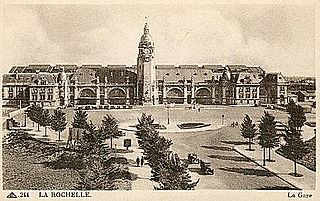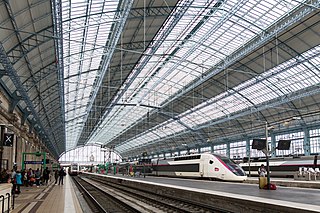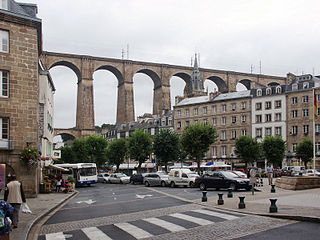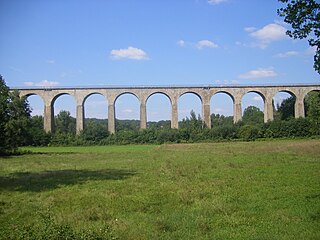
Gare Montparnasse, officially Paris Montparnasse, one of the seven large Paris railway termini, is located in the 14th and 15th arrondissements.

The Ligne de Sceaux was a railway line in France running from Paris, which initially linked the Place Denfert-Rochereau (then called the Place d'Enfer, in Paris, to the town of Sceaux.

Gare d'Austerlitz, officially Paris Austerlitz, is one of the seven large Paris terminal stations. The station is located on the left bank of the Seine in the southeastern part of the city, in the 13th arrondissement. It is the start of the Paris–Bordeaux railway; the line to Toulouse is connected to this line. In 1997, the Ministry of Culture designated the Gare d'Austerlitz a historical monument; it became the fifth large railway station in Paris to receive such a label, as currently only Montparnasse has not been attributed it.

Gare d'Orsay is a former Paris railway station and hotel, built in 1900 to designs by Victor Laloux, Lucien Magne and Émile Bénard; it served as a terminus for the Chemin de Fer de Paris à Orléans. It was the first electrified urban terminal station in the world, opened 28 May 1900, in time for the 1900 Exposition Universelle. After closure as a station, it reopened in December 1986 as the Musée d'Orsay, an art museum. The museum is currently served by the RER station of the same name.

The Chemins de fer de l'État, often referred to in France as the Réseau de l'État, was an early state-owned French railway company.

Musée d'Orsay is a station in line C of the Paris Region's Réseau express régional (RER) rapid transit system, named after the Musée d'Orsay, housed in the old Gare d'Orsay. It is in the 7th arrondissement of Paris. It was one of several stations attacked during the 1995 Paris Métro and RER bombings.

Gare d'Austerlitz is a station on the Paris Métro, serving line 5 and forming the eastern terminus of line 10 in the 5th and the 13th arrondissements. The Line 5 station hall, "probably the most atypical of the Paris Métro", is open to the exterior though under the roof of the mainline Gare d'Austerlitz and forms part of a sinuous elevated section which has been "considered an exceptional work of urban railway insertion".

Bordeaux-Saint-Jean or formerly Bordeaux-Midi is the main railway station in the French city of Bordeaux. It is the southern terminus of the Paris–Bordeaux railway, and the western terminus of the Chemins de fer du Midi main line from Toulouse. The station is the main railway interchange in Aquitaine and links Bordeaux to Paris, Sète, Toulouse Matabiau and Spain.

Tours station is a railway station serving the city of Tours, Indre-et-Loire department, western France. It is situated on the Paris–Bordeaux railway, the Tours–Saint-Nazaire railway, and the non-electrified Tours–Le Mans railway. The Gare de Tours is a terminus; most TGV trains only serve the nearby Gare de Saint-Pierre-des-Corps.

The gare des Aubrais is a main-line railway station located in the town of Fleury-les-Aubrais in Loiret, central France, and serving the greater Orléans district. It is situated on the Paris to Bordeaux railway and is also the northern terminus of the Orléans to Montauban line. TGV and most other long-distance trains serve only the Gare des Aubrais, and not the more central Gare d'Orléans.

The railway from Paris to Brest is a 622-kilometre long railway line in France that connects Paris and the western port city Brest, via Le Mans and Rennes. It is used for passenger and freight traffic.

The Paris–Le Havre railway is an important 228-kilometre long railway line, that connects Paris to the northwestern port city Le Havre via Rouen. Among the first railway lines in France, the section from Paris to Rouen opened on 9 May 1843, followed by the section from Rouen to Le Havre that opened on 22 March 1847.

The railway from Paris to Marseille is an 862-kilometre long railway line, that connects Paris to the southern port city of Marseille, France, via Dijon and Lyon. The railway was opened in several stages between 1847 and 1856, when the final section through Lyon was opened. The opening of the LGV Sud-Est high speed line from Paris to Lyon in 1981, the LGV Rhône-Alpes in 1992 and the LGV Méditerranée in 2001 has decreased its importance for passenger traffic.

The railway from Paris-Est to Strasbourg-Ville is a 493-kilometre-long railway line that connects Paris to Strasbourg via Châlons-en-Champagne and Nancy, France. Officially, the line does not start at the Gare de l'Est in Paris: the first 9 km until Noisy-le-Sec is shared with the railway from Paris to Mulhouse. The railway was opened in several stages between 1849 and 1852. The opening of the LGV Est high speed line from Paris to Baudrecourt in Lorraine in 2007 has decreased the importance of the section Paris–Sarrebourg for passenger traffic.

The railway from Paris-Est to Mulhouse-Ville is a 491-kilometre long railway line, that connects Paris to Mulhouse via Troyes, Chaumont and Belfort, France. The railway was opened in several stages between 1848 and 1858.

The railway from Bordeaux to Sète is an important French 476-kilometre long railway line, that connects the southwestern port city Bordeaux to the southern port Sète via Toulouse and Narbonne. The railway was opened in several stages between 1855 and 1858.
The railway from Creil to Jeumont is an important French 187-kilometre long railway line, that connects Creil, a northern suburb of Paris, to Jeumont on the Belgian border. It was opened in several stages between 1847 and 1855. The opening of the LGV Nord high speed line from Paris to Lille in 1993 has decreased its importance for passenger traffic.

The railway from Orléans to Montauban is an important French 544-kilometre long railway line, that connects Orléans and northern France to Montauban and southern France via Limoges. The railway was opened in several stages between 1847 and 1893, when the section from Limoges to Brive-la-Gaillarde was finished.

The Brive-la-Gaillarde - Toulouse railway is a 248-kilometre French railway line that connects the rural areas between Brive-la-Gaillarde and the large southern city of Toulouse via Figeac and Capdenac. The railway was opened in several stages between 1858 and 1864.

The Compagnie du chemin de fer de Paris à Orléans (PO) was an early French railway company.




















